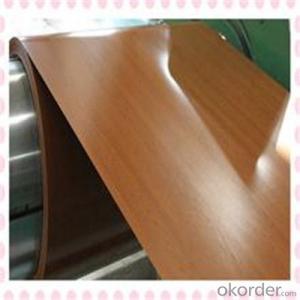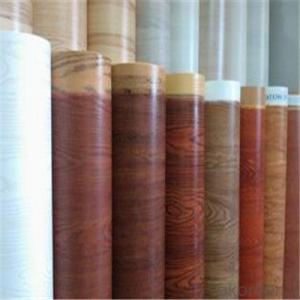Wood Pattern Coated Galvanized PPGI Steel Plates
- Loading Port:
- Shanghai
- Payment Terms:
- TT OR LC
- Min Order Qty:
- 30 m.t.
- Supply Capability:
- 1200000 m.t./month
OKorder Service Pledge
OKorder Financial Service
You Might Also Like
Item specifice
Description of Glove:
1. Environment friendly
2. Lower cost and maintenance
3. Long using time up to 10 years
4. Fast construction, time saving and labor saving
5. Easy cleaning
6. Antistatic
Festures of Glove:
Building industry | Outdoor application | Roof, structural balcony, panels, window sills, window frames, gates, garage doors, rolling doors, booths, shutters, watch rooms, makeshift houses, street waiting room (booth), refrigerators, etc. |
Indoor application | Room doors, dividing walls, door frames, light house steel structures, sliding doors, screens, ceilings, toilets, interior elevator lobby, stairwayventilating duct, communication pipelines. |
Specifications of Glove:
1. Aesthetics: Pre-Painted Galvanized steel sheet is available in plethora of patterns and multiple sizes as per the requirements that given by our customers.
2. Versatility: can be used in the various areas.
Images of Glove:

FAQ:
1.What about the delivery.
We can arrange the shipment about 15-25 days after the deposit.
2.What about payment term?
30% T/T deposit, balance against B/L copy.
Full T/T payment if quantity less than MOQ.
3.How much about MOQ?
Normally 100pcs,but small order is acceptable as well.
- Q:Where can I find a great deal online for Danesco Stainless Steel Egg Poacher
- Danesco okorder /
- Q:What are the common handling defects in steel coils?
- During the transportation and storage of steel coils, various handling defects can arise, impacting the coils' quality and integrity and potentially leading to future problems. Some of the most frequently encountered handling defects in steel coils are as follows: 1. Damage to the edges: This defect occurs when the coil's edges are bumped or scraped, resulting in dents, scratches, or tears. Such damage weakens the coil's structural integrity, making it more susceptible to further harm. 2. Core damage: The core of a steel coil plays a crucial role in maintaining its shape and stability. However, mishandling can crush or deform the core, leading to coil collapse or distortion. 3. Coil slippage: Inadequate strapping or stacking of coils can cause them to shift or slide during transportation. This can result in coil slippage, causing misalignment, damage to the outer layers, or even complete coil failure. 4. Abrasion: Steel coils can experience abrasion if they come into contact with rough surfaces or other objects during handling. This can lead to the wearing off of the coil's protective coating or paint, exposing the steel to potential corrosion. 5. Moisture damage: Steel coils are susceptible to moisture damage, particularly if they are not properly sealed or protected. Exposure to moisture can lead to rust formation, compromising the coil's structural integrity and overall quality. 6. Overloading: Exceeding weight limits and improper stacking of steel coils in trucks or storage areas can exert excessive pressure and stress on the coils, resulting in deformation, bending, or even coil collapse. Adhering to weight limits and proper stacking procedures is crucial to prevent overloading. 7. Improper lifting: When lifting steel coils, it is important to use suitable lifting equipment and techniques. Failure to do so can cause coil damage, such as distortion or bending, and can also pose risks of injury to workers. To mitigate these handling defects, it is vital to adhere to proper handling and storage procedures for steel coils. This includes using appropriate lifting equipment, securing coils during transportation, avoiding overloading, and ensuring adequate protection against moisture and abrasion. Regular inspections and maintenance are also important for identifying and addressing any potential defects or issues before they worsen.
- Q:What are the different types of steel coil cutting processes?
- Various industries utilize several different steel coil cutting processes. These processes include: 1. Shearing: The most widely used and simplest method of steel coil cutting involves utilizing a shear blade to cut the coil material into desired lengths. This can be done either manually or with the assistance of automated machinery. 2. Slitting: A process designed to cut wide coils into narrower strips, slitting involves passing the coil material through a set of circular knives that cut the steel into smaller coils or strips of the desired width. 3. Laser cutting: Renowned for its precision and efficiency, laser cutting involves using a high-powered laser to melt or vaporize the material along a predetermined path. This method is commonly employed for intricate designs or when high accuracy is required. 4. Plasma cutting: Another method of cutting steel coil involves using a plasma torch that generates a high-velocity jet of ionized gas to melt the material. Plasma cutting is known for its speed and ability to cut through thick materials. 5. Waterjet cutting: This process utilizes a high-pressure stream of water mixed with abrasive particles to cut through steel coil. Waterjet cutting is frequently chosen when the material being cut is sensitive to heat or when precision is necessary. 6. Saw cutting: A traditional cutting method, saw cutting involves using a saw blade with teeth to cut through the material. It is particularly effective for thicker materials and can be performed manually or with the aid of automated machinery. These represent just a few of the many steel coil cutting processes commonly employed. The choice of cutting method relies on several factors such as the material's type and thickness, desired accuracy, speed, and cost-effectiveness.
- Q:How many millimeters is a number 3 steel crochet hook?
- A okorder /. . If your hooks are marked by letters and milimeters, they are likely intended for working with YARN, not crochet thread. The steel hooks are smaller and are used with thread rather than with yarn. In addition, if you're working with a vintage pattern, a hook may be called for that you cannot purchase today. Here is a web site that explains many of the puzzling questions about hooks
- Q:this is for a school project due morrow can u please answerwhat are disadvantages of stainless steelplease also show were u got info ty
- Disadvantages of Stainless Steel: 1. High initial cost 2. Difficult to fabricate, or in other words, it is not as malleable as other metals, say iron, and hence if not fabricated properly, results in costly re-work. 3. Difficult to weld 4. High cost of polishing etc. i.e. adding finishing touches for the market. Also, for the record: Stainless steel does NOT rust. One of the advantages of it over other metals (steel and iron) are that it is rust-free. But of course, depending on the environment condition (E.g. long periods in a rainforest without use at all) it can rust....this is a very rare (and unfortunate) situation. ;)
- Q:My uncle got me some new 'Nam style jungle boots at the px at Fort Worth JSB, and he told me that back in Vietnam, they used to issue guys steel sole boots, that had a sole reinforced with a steel plate, as punji stick d-fence. Is this true, it sounds logical, but I can't figure out how a steel plate in the sole would work. My uncle is kind of a BS'er, plus he wasn't even in Vietnam, much less the Infantry, much less combat, but he was in USAF at the time.
- The issue of steel soled boots in Vietnam did actually happen. The steel plate is in the mid-sole, to prevent punji sticks (or other sharp objects) from penetrating the boot if you stepped down on them. These bamboo or metal spikes - often coated with human excrement - were placed in shallow (camouflaged) pits dug in the ground or sometimes under water at places where you'd ford a stream. Quite apart from the physical injury from stepping on one, there was a high risk of serious infection from what they were coated with. Originally the steel plate was issued as an insole to go inside but that give the soldiers blisters, so later the boots were manufactured with it as part of the sole. Steel toe-cap boots containing a mid-sole plate are sold today for use by builders and construction workers who have a similar risk of stepping on nails, screws, glass, etc.
- Q:Are Danielle steel books good to read. Im 15 , but do I have to wait until Im a bit older.
- I love her books, and your ok. Read one now, you'll love it.
- Q:Hey everyone.I have a whetstone and a honing steel. I purposely tried to make one of my knives less sharp twice to see how well the whetstone and honing steel would work.It even seemed that when I was using my whetstone it wasn't as sharp as it was when I used my honing steel, but when I also used my honing steel after having sharpened my knife on the whetstone, it was razor sharp.I was wondering, is the whetstone only supposed to be used when the knife edge isn't as flat anymore or something? Like, only when it doesn't really have an edge anymore?Please explain your answer.Thanks everyone.
- In general, whetstones will actually remove metal in order to sharpen a blade, and the angle they're used at is important too. A steel will just straighten the blade between uses, not actually remove metal. The effect is to make it sharper than it was just before, but only because it's straighter. Using a knife makes the very thin edge kind of flatten or even fold over a bit, or get wavy, etc...so the steel just straightens it back out (imagine what happens when the very thin blade gets pressed down repeatedly on a cutting board, or even cuts through foods repeatedly). (A whetstone is used only when steeling finally just isn't enough to get the blade sharp as needed.) .
- Q:How are steel coils used in the manufacturing of machinery?
- Steel coils are used in the manufacturing of machinery as they provide a reliable and durable material for various components and structures. These coils are often shaped, cut, and formed into desired parts such as gears, shafts, frames, and supports. The high strength and versatility of steel coils allow them to withstand heavy loads and harsh conditions, ensuring the machinery's efficiency and longevity.
- Q:How do steel coils compare to other types of metal coils?
- Steel coils are generally considered superior to other types of metal coils due to their exceptional strength, durability, and versatility. Steel coils have excellent resistance to corrosion, heat, and impact, making them suitable for various applications ranging from construction and automotive industries to manufacturing and packaging sectors. Additionally, steel coils exhibit excellent formability and can be easily shaped and molded into different shapes and sizes, offering greater flexibility and customization options.
1. Manufacturer Overview |
|
|---|---|
| Location | |
| Year Established | |
| Annual Output Value | |
| Main Markets | |
| Company Certifications | |
2. Manufacturer Certificates |
|
|---|---|
| a) Certification Name | |
| Range | |
| Reference | |
| Validity Period | |
3. Manufacturer Capability |
|
|---|---|
| a)Trade Capacity | |
| Nearest Port | |
| Export Percentage | |
| No.of Employees in Trade Department | |
| Language Spoken: | |
| b)Factory Information | |
| Factory Size: | |
| No. of Production Lines | |
| Contract Manufacturing | |
| Product Price Range | |
Send your message to us
Wood Pattern Coated Galvanized PPGI Steel Plates
- Loading Port:
- Shanghai
- Payment Terms:
- TT OR LC
- Min Order Qty:
- 30 m.t.
- Supply Capability:
- 1200000 m.t./month
OKorder Service Pledge
OKorder Financial Service
Similar products
New products
Hot products
Related keywords





























